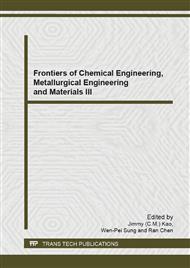p.284
p.288
p.292
p.297
p.303
p.308
p.312
p.317
p.321
A 2D Irregular Shape Model of Random Packing for Cement Particles
Abstract:
In this paper, an area-oriented algorithm based on a cellular automaton (CA) is proposed firstly to generate random irregular particles in a special area. The algorithm is used to reconstruct a 2D image with numerous irregular particles, the particles information is extracted from a 2D original image reprocessed from a BSE image of Cement CCRL-133 (NIST, USA). To make it more comparable, a uniform size 2D image is reconstructed by random packing of circle cement particles. In addition, the influence of cement particle shapes (circle and irregular) on initial surface areas and pore size information of initial cement paste microstructure is presented. Comparative results demonstrate that the 2D image reconstructed by irregular particles generating from the new algorithm is consistent with the original one.
Info:
Periodical:
Pages:
303-307
Citation:
Online since:
August 2014
Authors:
Price:
Сopyright:
© 2014 Trans Tech Publications Ltd. All Rights Reserved
Share:
Citation:


